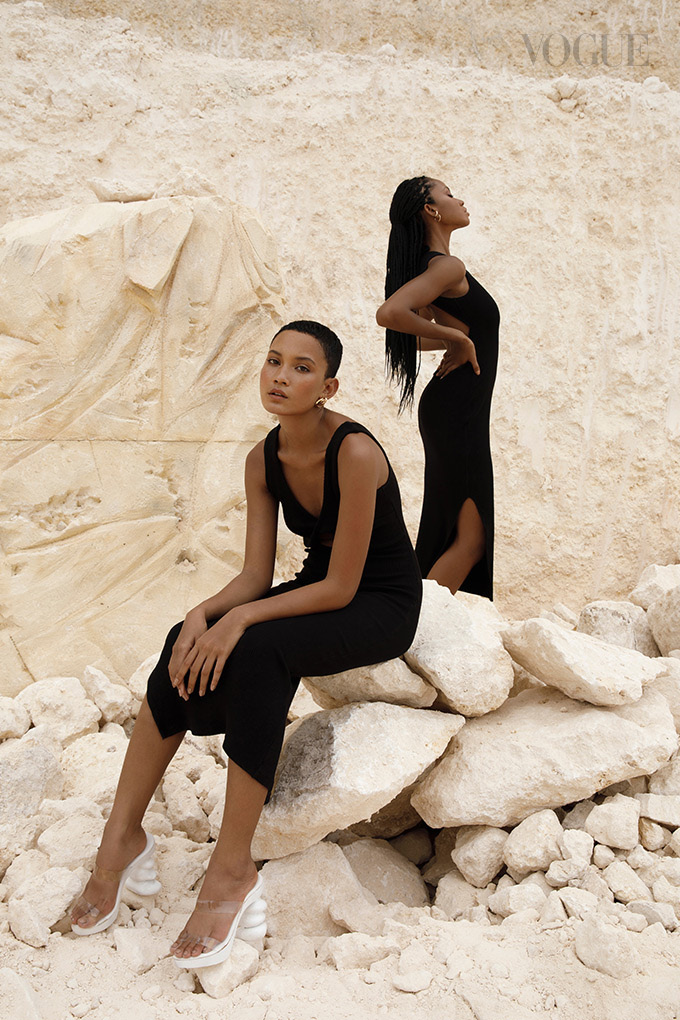Before she founded Sans Faff in 2020, Brandy Dallas was working in luxury fashion. Monochromatic basics were the foundation of her wardrobe, but she struggled to find pieces that were sustainable, well-made, and available at an affordable price point.
Dallas’s belief that you shouldn’t have to sacrifice your wardrobe in order to step up for the environment was what spurred her on to start Sans Faff. Featuring timeless wardrobe staples made from sustainably grown bamboo and other natural resources, the brand seeks to eliminate all traces of plastic from its supply chain to create garments that are both chic and kind to the earth.
Earlier this year, Dallas took her eco quest one step further. In partnership with Nu Cycle, a company that audits and offsets the waste created by a business’s supply chain, Sans Faff makes the case that more can always be done to build a sustainable future for the world of fashion.

Read on to discover the life cycle of a Sans Faff garment, from forest to fuel.
How it all begins

For Sans Faff’s latest collection, A New State of Being, Dallas introduced a new sustainable fabric, Enviro Rib. Custom created for the label, the material is soft, long-lasting and made entirely from bamboo. Unlike cotton, which can take up to 20,000 litres of water to produce 1kg of raw material, bamboo does not require any pesticides or irrigation for healthy growth—rainwater is sufficient.
Discovering this new resource has been a game changer for Dallas. Not only is it more sustainable than conventional textiles, according to Dallas, bamboo also “creates the most magical material ever. It’s a medium weight knit that doesn’t hang and keeps its shape. It’s breathable, which is ideal for Singapore’s climate and gives amazing structure to our garments.”
To create the Enviro Rib fabric, Dallas works with the two largest bamboo yarn manufacturers in China who also manage the bamboo plantations, giving her full transparency over the process. “We know for certain that our bamboo does not contribute to any habitat loss and is free from harmful chemicals. It is both Forest Stewardship Council (FSC) and Oeko-Tex certified,” she adds. While being kind to the planet, the resultant fabric, which is naturally organic, hypoallergenic and anti-bacterial, is also kind on your skin.
How it’s made

The quest for sustainable clothing stretches further than environmental impact. There is also the question of factory standards and fair wages. The production of Sans Faff garments takes place primarily in Singapore at the Jurong Town Corporation industrial estate, with supplementary manufacturing in China. By keeping production close to home, Dallas is able to ensure that her workers operate under safe conditions and are paid a fair price for their contributions.
How it arrives

Whether we’re shopping online or IRL, we often end up with significant amounts of unnecessary plastic packaging that, within minutes, ends up in the bin without a second thought. In Singapore alone, we discard an alarming 900 million kg of plastic every year, with only 4 percent of it being recycled. This material can take up to 500 years to decompose. Even then, tiny particles of it remain in our ecosystems as microplastics—making their way into the food we eat, air we breathe and even the water we drink.
When you shop at Sans Faff, everything you receive is 100 percent plastic-free, recyclable and biodegradable—from hang tags, packaging and mailer bags, to the actual garments themselves.
How it ends
Dallas has come to terms with the fact that one day, hopefully after at least seven good years of wear, your Sans Faff piece will come to the end of its life. In Singapore, that means incineration or ending up in a landfill. Unable to guarantee that her garments would be recycled, to Dallas, “it seemed very obvious that we needed to take extra measures in order to be accountable for our footprint”.
To accomplish this, the label partnered up with Nu Cycle, a waste-offsetting company that has done a full audit of Sans Faff’s supply chain, from “the cardboard spools that go on the yarn through to packaging, the number of pens used in a year, and our garments at the end of life”. In tandem with a third-party company in Indonesia, GEO-Trash Management, Nu Cycle removes the exact equivalent amount of waste being put into the environment by a brand’s supply chain from waterways and landfills, and converts it into fuel through a chemical process called pyrolysis.

As of May this year, Sans Faff has officially achieved waste-neutral status. “Ultimately, sustainability comes down to your brand’s impact and whether or not the impact has a positive or negative lasting footprint on our planet—you are either part of the solution or part of the problem as a consumer and business owner,” Dallas concludes.
Photography Amberly Valentine
Styling Niel Dimirij
Hair and make-up Rosarinho Rodrigues
Production and set design We are the Wilde Productions
Photography assistants Robert Casey and Gede Subawa
Models Firosa Noor and Alexa Lourdy/Castaway Model Management





